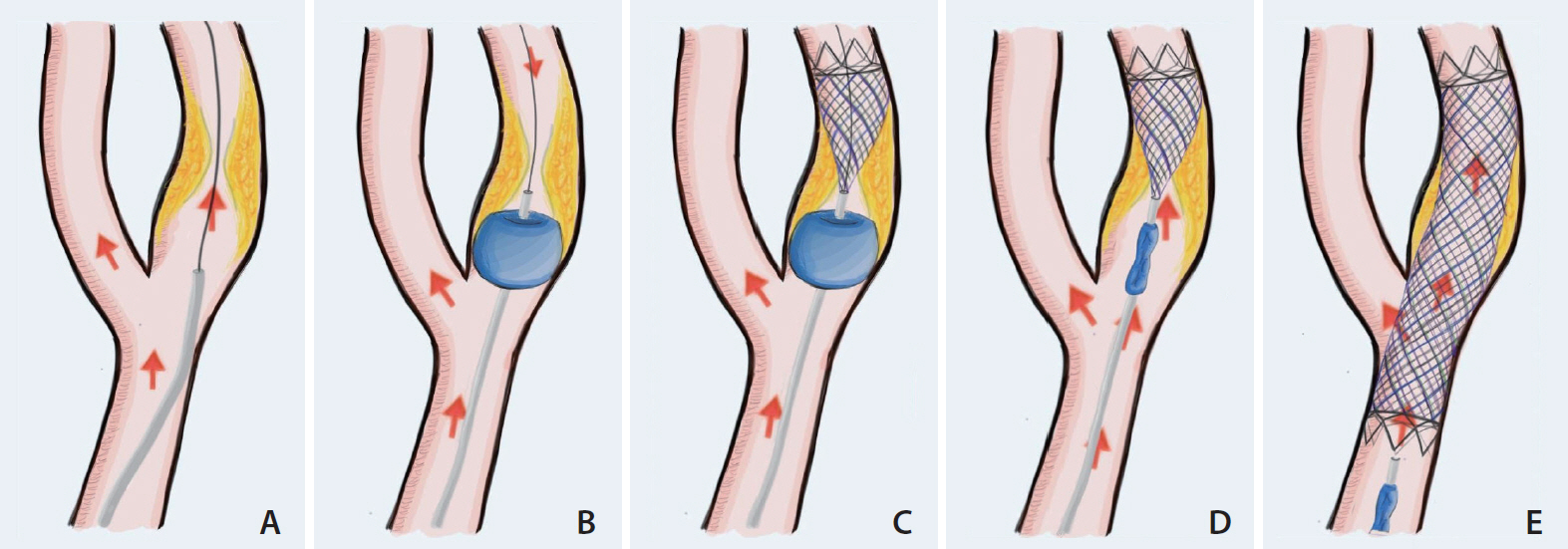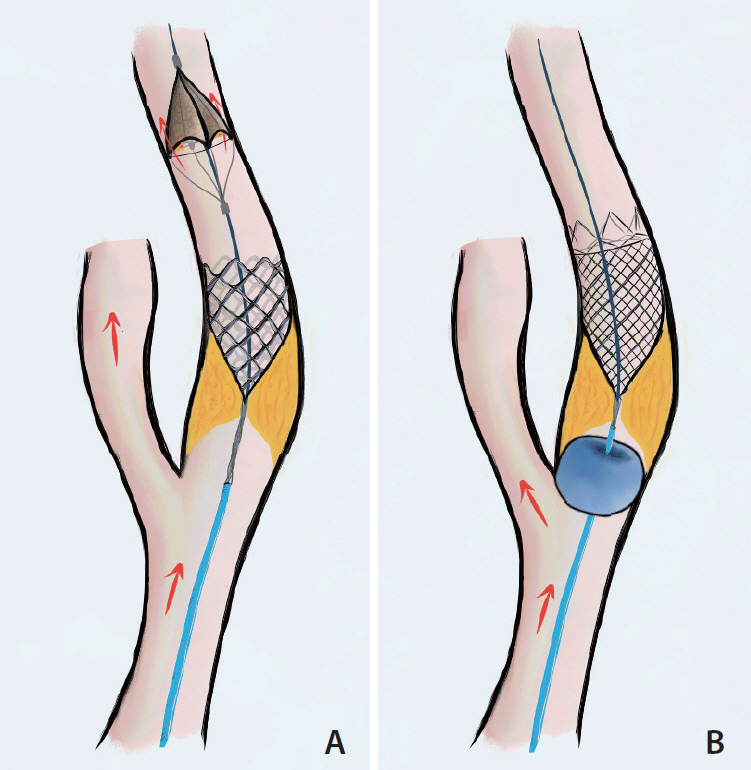Neurointervention.
2021 Nov;16(3):260-266. 10.5469/neuroint.2021.00353.
CaRotid Artery Filtering Technique (CRAFT): A Technique for Carotid Artery Stenting with Intrinsic Embolic Protection
- Affiliations
-
- 1Department of Radiology, Austin Hospital, Melbourne, Vic, Australia
- 2Department of Radiology, Alfred Health, Melbourne, Vic, Australia
- 3South Australian Health and Medical Research Institute, University of Adelaide, Adelaide, SA, Australia
- 4Department of Radiology, Royal Adelaide Hospital, Adelaide, SA, Australia
- 5Interventional Radiology Service, Department of Radiology, Northern Health, Melbourne, Vic, Australia
- 6School of Medicine, Faculty of Health, Deakin University, Waurn Ponds, Vic, Australia
- 7Interventional Radiology Service, Department of Radiology, St Vincent’s Hospital, Melbourne, Vic, Australia
- 8Interventional Neuroradiology Service, Department of Radiology, Monash Health, Melbourne, Vic, Australia
- 9Stroke Theme, The Florey Institute of Neuroscience and Mental Health, University of Melbourne, Melbourne, Vic, Australia
- KMID: 2522040
- DOI: http://doi.org/10.5469/neuroint.2021.00353
Abstract
- Purpose
Carotid artery stenting (CAS) is an established treatment for symptomatic carotid artery stenosis as an alternative to carotid endarterectomy. A variety of techniques and devices have been devised to minimise periprocedural stroke risk using either proximal or distal embolic protection. This study presents a method of embolic protection during CAS–the CaRotid Artery Filtering Technique (CRAFT).
Materials and Methods
The CRAFT technique employs aspects of both proximal and distal embolic protection. The CASPER RX stent (MicroVention, Tustin, CA, USA), which is a double-layered, closed-cell, micromesh nitinol stent, is deployed across the carotid artery stenosis with the assistance of a FlowGate balloon guide catheter (Stryker Neurovascular, Fremont, CA, USA). The partially deployed stent acts as a distal filter while the balloon guide is deflated midway during stent deployment to prevent distal plaque embolisation, followed by completion of stent deployment and angioplasty.
Results
A total of 94 patients underwent CAS using the CRAFT technique between June 2016 and March 2021. Successful stent deployment was achieved in all patients. Preliminary results demonstrated acute stent occlusion in 6 patients (6.4%) and distal embolic stroke in 5 patients (5.3%). The median procedural fluoroscopy time was 34 minutes with an interquartile range of 22 to 55 minutes.
Conclusion
The CRAFT technique of CAS presented by this study can be applied in the treatment of symptomatic carotid artery stenosis in both emergency and elective procedure settings with a high technical success and low distal embolic stroke risk.
Keyword
Figure
Reference
-
1. Müller MD, Lyrer P, Brown MM, Bonati LH. Carotid artery stenting versus endarterectomy for treatment of carotid artery stenosis. Cochrane Database Syst Rev. 2020; 2:CD000515.
Article2. Bonati LH, Gregson J, Dobson J, McCabe DJH, Nederkoorn PJ, van der Worp HB, et al. Restenosis and risk of stroke after stenting or endarterectomy for symptomatic carotid stenosis in the International Carotid Stenting Study (ICSS): secondary analysis of a randomised trial. Lancet Neurol. 2018; 17:587–596.3. Bonati LH, Dobson J, Featherstone RL, Ederle J, van der Worp HB, de Borst GJ, et al. Long-term outcomes after stenting versus endarterectomy for treatment of symptomatic carotid stenosis: the International Carotid Stenting Study (ICSS) randomised trial. Lancet. 2015; 385:529–538.
Article4. Lamanna A, Maingard J, Kok HK, Barras C, Jhamb A, Thijs V, et al. Carotid artery stenting in acute stroke using a microporous stent device: a single-center experience. World Neurosurg. 2019; 127:e1003–e1012.
Article5. Doig D, Turner EL, Dobson J, Featherstone RL, Lo RT, Gaines PA, et al. Predictors of stroke, myocardial infarction or death within 30 days of carotid artery stenting: results from the International Carotid Stenting Study. Eur J Vasc Endovasc Surg. 2016; 51:327–334.
Article6. Jansen O, Fiehler J, Hartmann M, Brückmann H. Protection or nonprotection in carotid stent angioplasty: the influence of interventional techniques on outcome data from the SPACE Trial. Stroke. 2009; 40:841–846.7. Yilmaz U, Körner H, Mühl-Benninghaus R, Simgen A, Kraus C, Walter S, et al. Acute occlusions of dual-layer carotid stents after endovascular emergency treatment of tandem lesions. Stroke. 2017; 48:2171–2175.
Article8. Montorsi P, Caputi L, Galli S, Ravagnani PM, Teruzzi G, Annoni A, et al. Carotid wallstent versus roadsaver stent and distal versus proximal protection on cerebral microembolization during carotid artery stenting. JACC Cardiovasc Interv. 2020; 13:403–414.9. Brott TG, Howard G, Roubin GS, Meschia JF, Mackey A, Brooks W, et al. Long-term results of stenting versus endarterectomy for carotid-artery stenosis. N Engl J Med. 2016; 374:1021–1031.
Article10. Garg N, Karagiorgos N, Pisimisis GT, Sohal DP, Longo GM, Johanning JM, et al. Cerebral protection devices reduce periprocedural strokes during carotid angioplasty and stenting: a systematic review of the current literature. J Endovasc Ther. 2009; 16:412–427.11. Touzé E, Trinquart L, Chatellier G, Mas JL. Systematic review of the perioperative risks of stroke or death after carotid angioplasty and stenting. Stroke. 2009; 40:e683–e693.
Article12. Naylor AR. Endarterectomy versus stenting for stroke prevention. Stroke Vasc Neurol. 2018; 3:101–106.
Article13. Akkaya E, Vuruskan E, Gul ZB, Yildirim A, Pusuroglu H, Surgit O, et al. Cerebral microemboli and neurocognitive change after carotid artery stenting with different embolic protection devices. Int J Cardiol. 2014; 176:478–483.
Article14. Bijuklic K, Wandler A, Hazizi F, Schofer J. The PROFI study (Prevention of Cerebral Embolization by Proximal Balloon Occlusion Compared to Filter Protection During Carotid Artery Stenting): a prospective randomized trial. J Am Coll Cardiol. 2012; 59:1383–1389.15. Texakalidis P, Letsos A, Kokkinidis DG, Schizas D, Karaolanis G, Giannopoulos S, et al. Proximal embolic protection versus distal filter protection versus combined protection in carotid artery stenting: a systematic review and meta-analysis. Cardiovasc Revasc Med. 2018; 19(5 Pt A):545–552.
Article16. Giugliano G, Stabile E, Biamino G, Petroni G, Sannino A, Brevetti L, et al. Predictors of carotid occlusion intolerance during proximal protected carotid artery stenting. JACC Cardiovasc Interv. 2014; 7:1237–1244.17. Jadhav A, Panczykowski D, Jumaa M, Aghaebrahim A, Ranginani M, Nguyen F, et al. Angioplasty and stenting for symptomatic extracranial non-tandem internal carotid artery occlusion. J Neurointerv Surg. 2018; 10:1155–1160.
Article
- Full Text Links
- Actions
-
Cited
- CITED
-
- Close
- Share
- Similar articles
-
- Extracranial Carotid Disease: An Interpretation of Extracranial Carotid Artery Disease Guideline 2011
- A Case of Transseptal Approach to Carotid Artery Stenting in Right Internal Carotid Stenosis
- Atherosclerotic Carotid Stenosis: Recent Update of Carotid Stenting
- Captured Macro-embolus of Fractured Atheromatous Plaque by the Embolic Protection Device during Carotid Stent Assisted Angioplasty
- Pseudo-no-Reflow Phenomenon in Carotid Artery Stenting using FilterWire EX: Successful Recovery by Aspiration Thrombectomy



